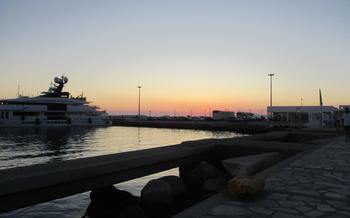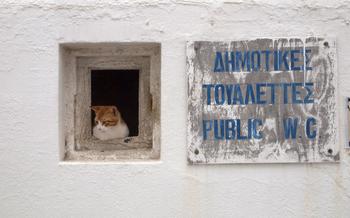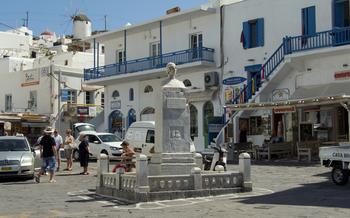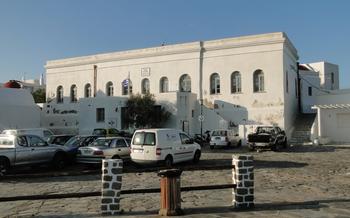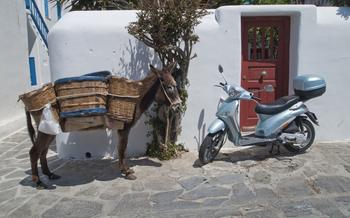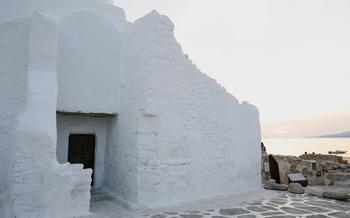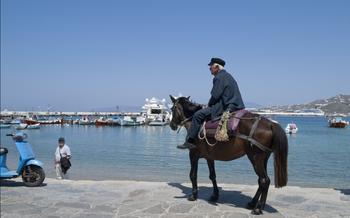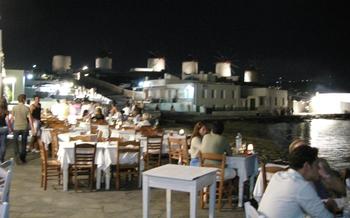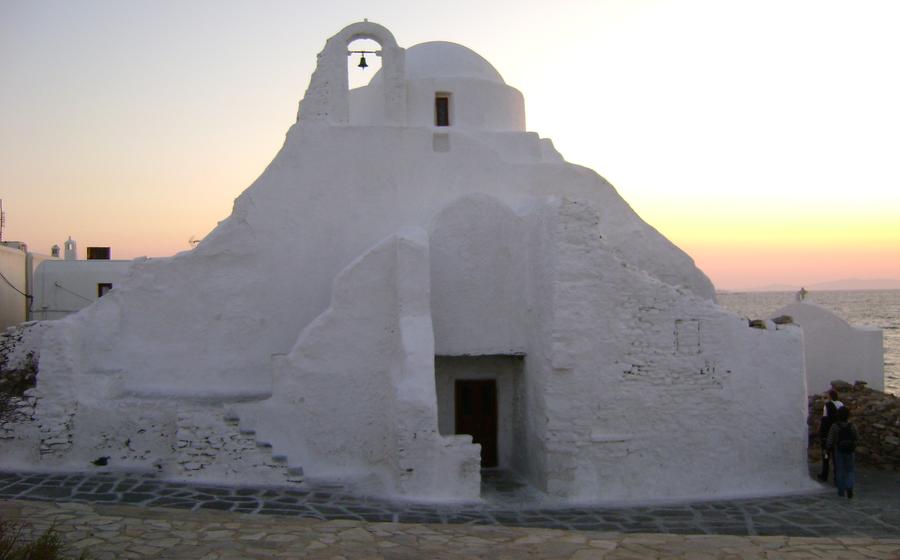
Paraportiani Church
- Historical Significance
- Location and Accessibility
- Architectural Details
- Interior Beauty
- Historical Context
- Religious Significance
- Photo Opportunities
- Admission and Hours
- Guided Tours
- Nearby Attractions
- Accessibility for Visitors with Disabilities
- Local Customs and Traditions
- Unique Features
- Restoration and Preservation
- Insider Tip
Historical Significance
The Paraportiani Church, a striking architectural marvel in Mykonos Town, holds a significant place in the island's history and religious heritage. Its origins date back to the 15th century, when five small churches were merged into a single structure to create a unique and iconic masterpiece. The church's name, derived from the Greek word "paraporti," meaning "side door," reflects its location next to a small gate in the town's fortifications.
The Paraportiani Church showcases a distinctive architectural style that blends Byzantine and Cycladic influences. Its whitewashed exterior, a characteristic feature of Mykonian architecture, exudes a sense of purity and simplicity. The intricate dome design, reminiscent of Byzantine churches, adds a touch of grandeur and sophistication to the structure.
Beyond its architectural significance, the Paraportiani Church holds deep religious and cultural importance for the people of Mykonos. Dedicated to the Assumption of the Virgin Mary, the church is a sacred place of worship and pilgrimage. Its patron saint, Panagia Tourliani, is revered by the locals, and her feast day on August 15th is celebrated with great devotion and festivities.
Location and Accessibility
The Paraportiani Church stands proudly in the heart of Mykonos Town, on the picturesque Cycladic island of Mykonos, Greece. Its exact address is Kalogera Street, Mykonos Town 846 00. To reach this iconic landmark, visitors can conveniently stroll through the charming cobblestone streets of Mykonos Town, immersing themselves in the vibrant atmosphere and local culture.
Reaching the Paraportiani Church is a breeze, as it is easily accessible by foot or by public transportation. For those who prefer to take the scenic route, the church is within walking distance from most hotels and popular tourist spots in Mykonos Town. Alternatively, visitors can opt for the convenience of public buses, which stop nearby, providing a hassle-free and affordable mode of transportation. For those arriving by private vehicle, limited parking is available in the vicinity, although it's advisable to prioritize walking or public transportation to avoid congestion in the narrow streets.
To fully appreciate the church's serene ambiance and avoid the throngs of tourists, it's recommended to visit during the shoulder seasons (May-June and September-October) when the crowds are smaller. Early mornings or late afternoons, when the golden sunlight casts a warm glow over the whitewashed facades, offer the most enchanting experience.
Architectural Details
The Paraportiani Church stands as a testament to the remarkable architectural heritage of Mykonos. Its distinctive Cycladic style, characterized by whitewashed exteriors and simple, geometric lines, blends seamlessly with the island's picturesque landscape. The church's unique design, with its multiple chapels clustered together, creates a visually striking ensemble that captivates visitors from afar.
Byzantine influences are evident in the church's intricate dome design, which features a series of concentric rings and a cross at the apex. This architectural element adds a touch of grandeur to the otherwise humble structure. The church's multiple chapels, each dedicated to a different saint, are connected by a labyrinth of narrow passageways and staircases, creating a sense of mystery and intrigue.
The interior of the church is adorned with stunning frescoes and religious artwork, which depict scenes from the Bible and the lives of the saints. The iconostasis, a screen that separates the sanctuary from the nave, is a masterpiece of craftsmanship, with intricate carvings and gilded accents. The church's peaceful and spiritual atmosphere invites visitors to pause, reflect, and connect with their inner selves.
Interior Beauty
As you step inside the Paraportiani Church, your eyes will be captivated by the stunning frescoes and religious artwork that adorn its walls. The frescoes, painted in vibrant colors, depict scenes from the Bible and the lives of saints. The iconostasis, a partition that separates the nave from the sanctuary, is a masterpiece of intricate carvings and gilded ornamentation. The church's interior exudes a peaceful and spiritual atmosphere, inviting visitors to sit in quiet contemplation and appreciate the beauty of this sacred space.
Historical Context
The Paraportiani Church stands as a testament to Mykonos' rich history, having played a significant role in shaping the island's cultural and religious identity. Its construction during the 14th and 15th centuries coincided with the Venetian rule of Mykonos, leaving an indelible mark of Venetian influence on its architectural style. The church's unique design and construction techniques reflect the fusion of Byzantine and Cycladic architectural traditions, embodying the island's cultural heritage.
Throughout the centuries, the church has endured various challenges, including the Ottoman occupation of Mykonos. Despite facing adversity, the Paraportiani Church remained a beacon of resilience, serving as a place of worship and refuge for the local population. Its enduring presence symbolizes the indomitable spirit of the Mykonian people and their unwavering devotion to their faith. Today, the church stands as a symbol of Mykonos' cultural heritage, attracting visitors from around the world who seek to marvel at its architectural beauty and delve into the rich history it represents.
Religious Significance
The Paraportiani Church holds immense religious significance to the people of Mykonos. It serves as a place of worship and pilgrimage for both locals and visitors seeking spiritual guidance and connection. The church is dedicated to the patron saint of Mykonos, Agia Eleni, or Saint Helen. According to local tradition, Saint Helen appeared in a dream to a young shepherdess, instructing her to build a church on the site where the Paraportiani Church now stands. This divine intervention led to the construction of the church, which has since become a symbol of faith and devotion for the people of Mykonos.
The church is a popular destination for religious festivals and celebrations. During the annual feast of Saint Helen, which takes place on May 21st, the church becomes a hub of activity. Devotees from all over the island gather to honor their patron saint, participating in processions, prayers, and traditional dances. The church's unique architecture and spiritual atmosphere create a captivating setting for these religious observances, fostering a sense of community and shared faith among the people of Mykonos.
Photo Opportunities
The Paraportiani Church is an architectural masterpiece and a photographer's dream. Capture the church's grandeur against the vibrant blue sky, creating stunning contrasts and dramatic compositions. Explore the narrow streets and alleys surrounding the church to find unique angles and perspectives. The church's whitewashed exterior glows in the golden light of sunset, providing a magical backdrop for silhouettes and romantic shots. For a bird's-eye view, climb the nearby Kato Myli Windmill or find a rooftop terrace in Mykonos Town to capture the church nestled amidst the whitewashed buildings. Don't forget to snap some interior shots of the stunning frescoes, intricate carvings, and peaceful ambiance. Respect the sanctity of the church and avoid using flash photography or causing disruption during religious services. With its picturesque charm and iconic status, the Paraportiani Church offers endless opportunities for capturing memorable photographs.
Admission and Hours
Admission to the Paraportiani Church is free of charge, allowing visitors to experience its beauty and spiritual essence without any financial barriers.
The church is open to the public daily, with its opening hours varying slightly depending on the season. During the summer months, from April to October, the church is typically open from 8:00 am to 8:00 pm. In the winter months, from November to March, the opening hours are usually from 9:00 am to 5:00 pm.
It's worth noting that the church may be closed during religious services or special events. To avoid any inconvenience, it's advisable to check the official website or contact the local tourism office for the most up-to-date information on opening hours.
When visiting the church, it's important to adhere to the dress code and behave respectfully. Visitors are expected to dress modestly, covering their shoulders and knees. Taking photographs inside the church is generally permitted, but it's essential to be mindful of the ongoing religious activities and maintain a peaceful atmosphere.
Guided Tours
For a more in-depth understanding of the Paraportiani Church's history, architecture, and religious significance, guided tours are highly recommended. These tours are led by knowledgeable and experienced guides who can provide insights and anecdotes that bring the church's story to life. Guided tours are available in various languages, ensuring that visitors from all over the world can learn about this iconic landmark.
Booking a guided tour is simple and can be done online or through local tour operators in Mykonos. Whether you're interested in a comprehensive overview or a specialized tour focused on specific aspects of the church, there are options to suit every interest.
During the tour, your guide will lead you through the church's intricate chapels, explaining their significance and pointing out the stunning frescoes and religious artwork that adorn the walls. They will also share stories about the church's construction, its role in the history of Mykonos, and its enduring importance to the local community.
By taking a guided tour, you'll gain a deeper appreciation for the Paraportiani Church and its place in the cultural and religious heritage of Mykonos. It's an experience that will stay with you long after your visit.
Nearby Attractions
The Paraportiani Church stands as a remarkable gem amidst a constellation of captivating attractions in Mykonos Town. A short stroll from the church unveils the picturesque Agios Nikolakis Church, exuding its charm with its quaint whitewashed facade and blue-domed roof. For those seeking a journey into the depths of history, the Mykonos Folklore Museum, nestled nearby, beckons with its rich collection of traditional costumes, artifacts, and handicrafts, providing a glimpse into the island's vibrant past.
Venturing beyond the immediate vicinity, Mykonos Town unveils a treasure trove of hidden gems. Lose yourself in the labyrinthine cobblestone streets, lined with charming boutiques, art galleries, and tavernas exuding authentic Greek hospitality. Indulge in the flavors of Mykonos at one of the many restaurants, savoring the freshest seafood, succulent meats, and delectable local delicacies.
Embrace the island's vibrant energy by venturing to the iconic windmills, standing tall against the backdrop of the azure Aegean Sea. Capture the essence of Mykonos at Little Venice, where colorful houses with wooden balconies line the waterfront, creating a picture-perfect setting. Dive into the crystal-clear waters of Agios Stefanos Beach, a short walk from the town, and bask in the Mediterranean sun while enjoying the panoramic views.
Accessibility for Visitors with Disabilities
The Paraportiani Church is committed to ensuring accessibility for visitors with disabilities. Wheelchair ramps and designated areas for wheelchairs and strollers are available to facilitate ease of movement within the church. Visitors with limited mobility can request assistance from the church staff, who are trained to provide support and ensure a comfortable experience for all. The church's accessible features allow everyone to appreciate its beauty and spiritual significance, fostering an inclusive environment for all visitors.
Local Customs and Traditions
When visiting the Paraportiani Church and Mykonos in general, it is important to be respectful of local customs and traditions. Dress modestly and avoid wearing revealing clothing, especially when visiting religious sites. Be mindful of noise levels and avoid disturbing others who may be praying or enjoying the peaceful atmosphere.
When interacting with locals, be polite and friendly, and try to learn a few basic Greek phrases. Respect local customs and traditions, such as greeting people with a handshake or a nod, and avoid discussing sensitive topics like politics or religion. Remember that Mykonos is a popular tourist destination, and locals may be accustomed to interacting with visitors from different cultures, but it is always appreciated when visitors make an effort to understand and respect local ways of life.
Unique Features
The Paraportiani Church stands out for its unique construction techniques, setting it apart from other churches in Mykonos. Built without the use of mortar, its whitewashed walls are held together by a complex system of interlocking stones. This ingenious technique, a testament to the skill of the island's craftsmen, has allowed the church to withstand the test of time and the harsh winds that sweep across Mykonos.
Another distinguishing feature of the Paraportiani Church is its association with legends and folklore. According to local tradition, the church was built by a single monk using only his hands and a donkey. Legend has it that the monk was aided by a mysterious presence that guided him in his work, ensuring the church's remarkable construction.
The Paraportiani Church is also known for its distinctive features that set it apart from other churches. Its multiple chapels, each dedicated to a different saint, create a sense of intimacy and devotion within the larger structure. The church's bell tower, with its intricate carvings and melodic chimes, adds a touch of elegance and charm to the overall design.
These unique features, from its construction techniques to its legendary origins and distinctive architectural elements, make the Paraportiani Church a one-of-a-kind landmark that captivates visitors with its beauty, history, and cultural significance.
Restoration and Preservation
The Paraportiani Church has undergone several restoration and preservation efforts throughout its history. In the early 20th century, the church was in a state of disrepair, with its whitewashed exterior fading and its interior frescoes deteriorating. In response, a major restoration project was undertaken, which involved cleaning and repainting the exterior, repairing the interior frescoes, and reinforcing the structure of the church.
Since then, ongoing conservation work has been carried out to maintain the church's structural integrity and preserve its unique architectural features. This includes regular maintenance, cleaning, and repairs, as well as the use of specialized techniques to protect the frescoes from environmental damage.
The preservation of the Paraportiani Church is of utmost importance, as it is a valuable cultural heritage site that represents the rich history and traditions of Mykonos. By protecting and restoring this iconic landmark, future generations can continue to appreciate its beauty and significance.
Insider Tip
For an unforgettable experience, venture beyond the main tourist areas and seek out the hidden gems of the Paraportiani Church. One such spot is the small courtyard located behind the church, offering a tranquil oasis away from the crowds. Here, you can sit on a bench, admire the intricate architectural details up close, and soak in the peaceful atmosphere.
Another secret spot is the rooftop terrace of a nearby building, which provides breathtaking panoramic views of the church and the surrounding town. From this vantage point, you can capture stunning photos and enjoy a unique perspective of Mykonos' iconic landmark.
To truly immerse yourself in the church's history and significance, consider joining a guided tour led by a local expert. These tours often provide fascinating insights into the church's construction, religious traditions, and connection to the island's culture.
Remember to be respectful of local customs and traditions while visiting the Paraportiani Church. Dress modestly, maintain a quiet and reverent demeanor, and avoid taking photos during religious services. By following these guidelines, you can contribute to preserving the sacredness of this cherished landmark.
